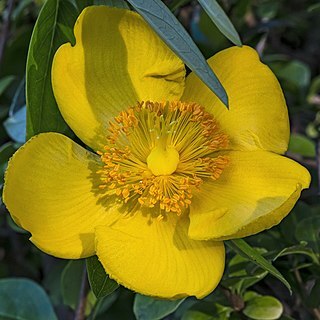Herbs, annual or perennial, subshrubs, or shrubs [trees], sometimes rhizomatous, glabrous or hairy, with glandular canals, lacunae, or dots containing resins or waxes (amber), essential oils (pale, translucent), and/or, sometimes, hypericin and pseudohypericin (black or red) in various parts. Stems: internodes terete (not lined) or 2-, 4-, or 6-lined at first (lines usually raised), then sometimes becoming angled, terete, or winged; <bark smooth or striate, sometimes corky, punctiform. Inflorescences terminal, cymose, 2+-flowered, or flowers solitary, branching stellate [cupulate]; sepals persistent or deciduous, (3–)4–5, distinct or ± connate, margins sometimes glandular-ciliate; petals persistent or deciduous, (3–)4–5[–6], contorted, yellow to orange, sometimes red-tinged; stamens persistent or deciduous, (5–)10–300(–650), in continuous or interrupted ring or in (3–)4–5 fascicles, fascicles distinct or connate, each with 1–60+ stamens; filaments distinct or basally connate; anthers yellow to orange, oblong to ellipsoid, almost isodiametric, sometimes with amber or black gland on connective; staminode fascicles 0 [3]; ovary 2–5-merous; placentation axile to parietal; ovules 2+ on each placenta; styles distinct or ± connate basally, spreading to ± appressed. Capsules 2–5-valved, sometimes with glandular vittae or vesicles. Seeds narrowly cylindric to ellipsoid, sometimes carinate; testa foveolate or reticulate to scalariform [papillose]. x = 12, 9–7, 6 (dihaploid).
Trees, shrubs or perennial to annual herbs, glabrous or with simple hairs, with glandular canals or locules containing resins (amber), essential oils (pellucid) and often hypericin and pseudohypericin (black or red). Leaves opposite, entire, rarely gland fringed, sessile or shortly petiolate, the venation subparallel or variously reticulate, pellucid or dark glands present on lamina or margins. Inflorescences 1-many-flowered, usually dichasial, terminal and some-times also axillary, with branches regularly bracteate and bracteolate, sometimes foliate; the bracts often foliaceous; pedicels usually present. Flowers homostylous or rarely heterostylous, the perianth usually radiate to cupulate; sepals 5, quin-cuncial, or occasionally 4 and decussate, glandular like the leaves; petals 5(4), contorted in bud, yellow to orange or rarely white, often tinged or veined with red in areas exposed in bud, usually asymmetric, variously glandular, deciduous or persistent, glabrous; stamen fascicles free, variously united or sometimes ap-parently absent, deciduous or persistent, glabrous, each with many to few
stamens, or rarely reduced to 1 stamen, the filament slender, usually free almost to the base, the anther oblong or elliptic with an amber or dark gland on the connective; staminodial fascicles absent or rarely 3, glabrous; ovary glabrous, 3-5-locular with axile placentas or completely unilocular with (2-)3-5 parietal placentas, each placenta with 2-many ovules, the styles (2-)3-5, free or partly to completely united, glabrous, the stigma small or broadly capitate. Fruit a septicidal capsule, occasionally fleshy and tardily dehiscent, the (2-)3-5 valves often with resin-containing vittae or vesicles, 1-many-seeded; seeds small, the testa variously sculptured, often carinate or winged, the embryo slender, straight, with distinct straight cotyledons.
Deciduous or evergreen herbs, often with annual stems, or shrubs; stems often angular. Lvs opposite or whorled, usually entire, often dotted with glands. Fls in terminal panicles or cymes, sometimes solitary, sometimes axillary, ☿, occasionally distylous. Sepals (4)-5, often unequal. Petals (4)-5, nearly always yellow, often oblique, contorted in bud. Stamens usually numerous, sometimes few, usually connate at base in 3 or 5 (rarely 4) bundles, sometimes antipetalous. Ovary 1-5-locular, with parietal or axile placentation, if 1-locular then with 3-5 parietal placentae. Styles (2)-3-5, free or connate. Fr. usually a septicidal capsule, more rarely baccate.
Perianth 4–5-merous; sep persistent, often unequal, sometimes only 2 fully developed; pet convolute, typically yellow, occasionally more orange or coppery; stamens 5 to more often ± numerous, distinct or ± connate at base, often into 3 or 5 definite bundles; no hypogynous glands; ovary 2–5-carpellate, unilocular or partly or wholly plurilocular, often with intruded partial partitions; styles persistent, often connate below; fr capsular; seeds short-cylindric, areolate; herbs or shrubs with cymose (rarely solitary) fls. (Ascyrum, Sarothra) 400, mainly N. Temp.
Fls 5-merous; ovary 1-celled with parietal, or 3-5-celled with axile placentae. Fr. capsular to baccate. Some 300 spp., mainly of temperate regions.


